One person can never see a city. You can miss it, hate it, or realize that it’s taken something from you, but you can’t go somewhere and look at it and just see it empirically. It has to be informed, imagined, by many people at a time. It’s an everyday group hallucination. –Bernadette Corporation, Reena Spaulings1
An Urban Hallucination
Stranger than the cave man and the sugar queen, the red aliens, the troop of zombie mimes, the anarchists, the immigration activists, and the protest signs was the emptiness that preceded, suffused, and followed the parade. I walked down the middle of a vacant Broadway. Police blocked traffic, and somewhere around the corner on Venice, like an impending hallucination, were the Trespass Parade floats. Soon they were rolling through downtown Los Angeles along the historic Broadway corridor, joined by a growing crowd of some two hundred dancers and marchers, a mixture of the militant and the carnivalesque. Arto Lindsay and his band led the way on a mobile stage, pumping the streets full of sludgy Brazilian and beatbox rhythms steeped in New York noise. Videographers and Freeline skaters darted everywhere.
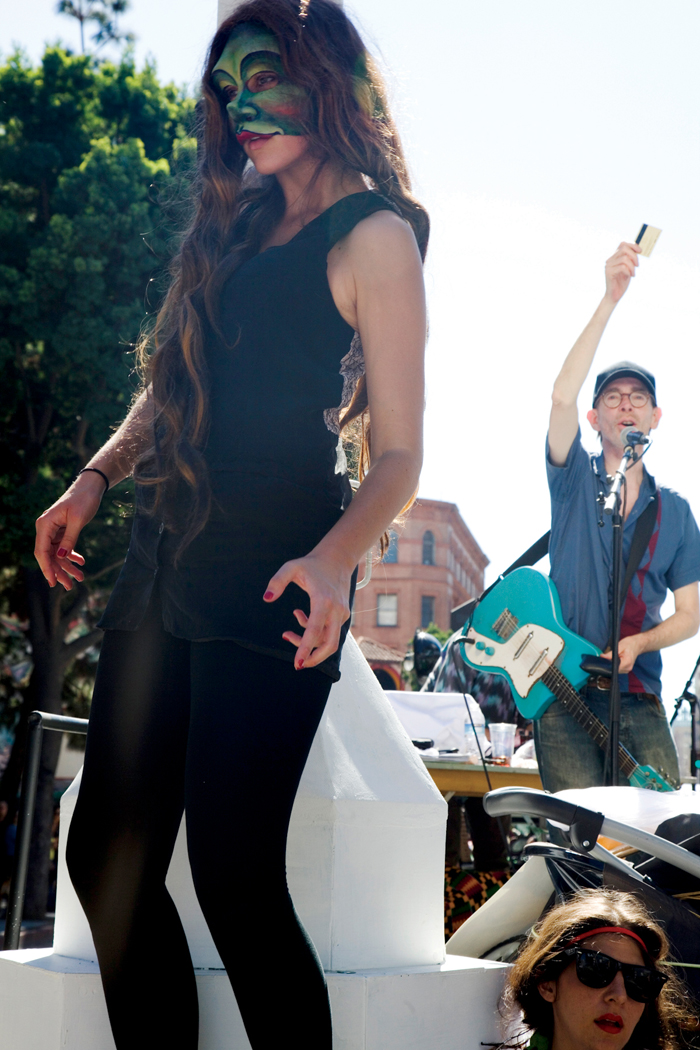
Arto Lindsay, Rirkrit Tiravanija, and West of Rome Public Projects, Trespass Parade, October 2, 2011, Los Angeles. Courtesy of West of Rome Public Art, Pasadena, Ca. Photo: Tina Hosseinzadeh.
It was a fun art parade that at times seemed to occupy an interstitial city, to exist between and within the regimentation of everyday life. The police, as they ushered Trespass from block to block, appeared banal yet out of place. Indeed, in its ambivalence towards the realities of Los Angeles—the deployment of power in particular —Trespass exemplified the surreal complacency in which art of this kind—relational art, public art—has entrenched itself. The press release described the parade, organized by Lindsay, Rirkrit Tiravanija, and West of Rome Public Projects, as “a catalyst for change” between “a high-octane roster of important local artists, the resident Downtown population, and the architecture in the area. The project invites Los Angeles to gather and occupy the streets of our city as an act of community activism in this time of world turmoil…”2 Yet despite its name, Trespass Parade began by asking permission, then proceeded within the parameters designated for precisely such actions. “An event programmer and an urban planner lurk behind every relational artist,” writes John Kelsey, “and these practitioners’ proposals to re-appropriate common space were always elaborated in a strict and conscious relation to the fact of functionalized, policed space.”3 Part of the opening festivities of the Getty’s Pacific Standard Time initiative—sponsored by Bank of America—Trespass was billed as the only PST event to occur in public space. This fact either suggests that public art has been in some way terminally problematized, or underscores the need for art to be more than an empty placeholder for direct action.
Trespass called itself a parade, but rhetorically and formally aligned itself with the demonstration. Its generalized, blanket politics succeeded all too well in aestheticizing a political form already cordoned off and under siege. Lindsay has organized several parades in recent years—in Venice for the 2009 Biennale; in Salvador, Brazil, for Matthew Barney’s video de lama lamiña; and most recently with Rirkrit Tiravanija for the 2010 Nuit Blanche in Paris. Trespass also recalls Pierre Huyghe’s Streamside Day parade, held in celebration of an invented holiday.4 Huyghe purported to generate a sense of common origin for a bland housing development more or less devoid of specific history. Los Angeles, on the other hand, is already dense with psychic residue. Along a route shared by past May Day marches, and joined by protesters from Occupy L.A. at City Hall a few blocks away, Trespass moved forward in the belief that any action is better than no action—that in the aftermath of idealism, “anyactionwhatever” is good enough.
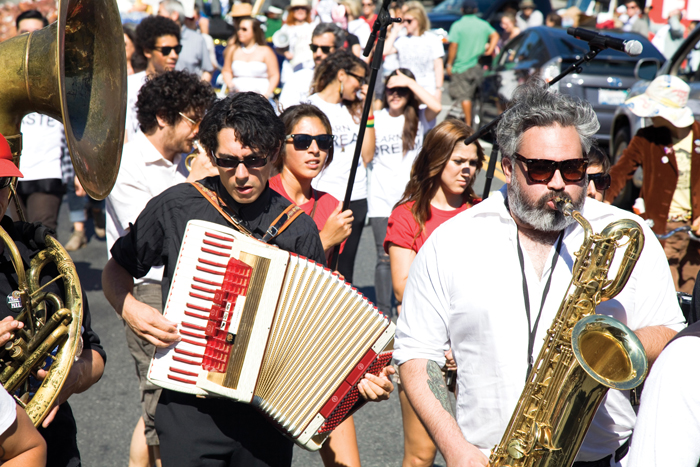
Arto Lindsay, Rirkrit Tiravanija, and West of Rome Public Projects, Trespass Parade, October 2, 2011, Los Angeles. Courtesy of West of Rome Public Art, Pasadena, Ca. Photo: Tina Hosseinzadeh.
History of Course
The parade followed a path up the Broadway corridor overlapping that of the May Day march, which since 2008 has progressed from the intersection at Olympic on Broadway towards City Hall. One group behind Lindsay’s band held up letters to spell “ILLEGAL?” and “OCCUPY,” a kind of afterimage or flashback of the 2011 May Day rally, which focused heavily on immigration reform. The implicit demonstration haunted the parade like the lingering warmth of thousands of politicized bodies. When it comes to direct political action, however, it’s unclear what art provides that the May Day rally can’t.
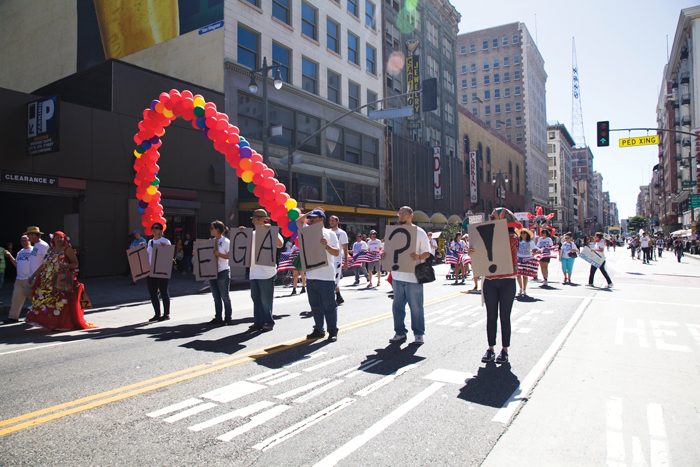
Arto Lindsay, Rirkrit Tiravanija, and West of Rome Public Projects, Trespass Parade, October 2, 2011, Los Angeles. Courtesy of West of Rome Public Art, Pasadena, Ca. Photo: Tina Hosseinzadeh.
Framing itself within the beautiful historic architecture of the old Theater District, Trespass Parade began at the L.A. Mart, where the Art Platform Los Angeles art fair was in progress, and terminated at the Museum of Contemporary Art. Both institutions sponsored the event. New marchers gathered and artists gave speeches at stops along the route in front of several other landmarks— Clifton’s Cafeteria, the Eastern building, and the Bradbury Building. Perhaps the route was less unbounded than it appeared, determined in part by the wishes of certain sponsors or by the permitting process. May Day marchers no longer have the luxury of choosing their site. The annual rally had previously been held in Macarthur Park, one of the city’s densest neighborhoods, but after police there arrested and beat hundreds of May Day demonstrators in 2007, the route was relegated to downtown. The Broadway corridor is sparsely populated, out of sight, easily blocked off, and as such is the site of resistance preferred by the LAPD.
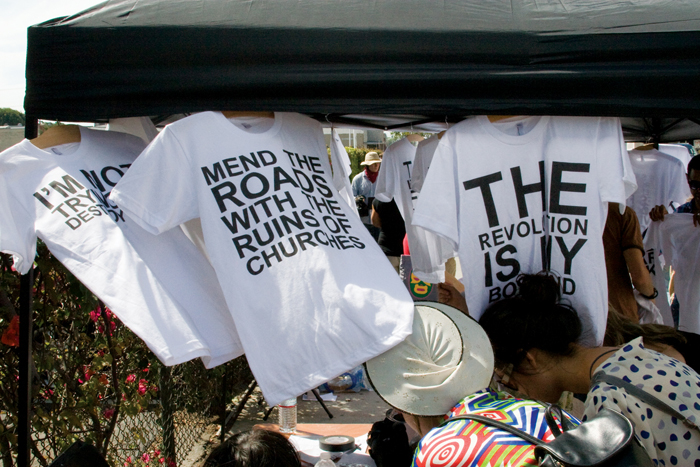
Arto Lindsay, Rirkrit Tiravanija, and West of Rome Public Projects, Trespass Parade, October 2, 2011, Los Angeles. Photo: Travis Diehl.
Excess ≠ Success
Tiravanija’s most visible contribution to Trespass was a series of white t-shirts printed with slogans coined by himself and dozens of Los Angeles artists. The shirts, in Tiravanija’s words, “reflect the limitless possibilities of free speech,” and include: “THE SUPREME COURT IS A TERRIBLE THING TO WASTE,” “I’M NOT TRYING TO DESTROY YOU,” “DON’T CURRY, BE HAPPY,” and “EXCESS ≠ SUCCESS.”5 It’s remarkable that so many artists—a long list of local politically active art makers and Southern California standbys, including John Baldessari, Barbara Kruger, Andrea Bowers, Chris Burden, Edgar Arceneaux, Walead Beshty, My Barbarian, Jeffery Vallance —the list goes on—accepted the invitation to engage with such a circumscribed form. While individually they are interesting and even radical artists in their own right, here in concert, under the Trespass / Rirkrit Tiravanija / Arto Lindsay / West of Rome label, the sheer number of slogans tumbled together into a generalized “progressive message.” For Tiravanija, it would seem the simple fact of expression is enough. Kruger’s slogan, “TALK IS CHEAP, FREE SPEECH IS PRICELESS,” exchanges “free speech” for “action.” Indeed, in its ambiguous positivity, this phrase encapsulates the undifferentiated position of Trespass. The parade upheld a politics of the anyactionwhatever that could be anything, produce anything, mean anything—an entirely potential action.
Trespass channeled the energy of participating artists into a kind of mobile “free speech zone,” within which “anything could happen,” but in this there is no trespassing. Is it free speech if you’ve first paid for all the proper permits? Slogans appeared on signs, banners, t-shirts, and as chants—a vacant affirmation within a format already well declared for such a purpose. Tiravanija’s project in particular promoted a notion of empty democracy—empty in the sense that the artwork is a container that makes no judgments on what it contains, but reaches no conclusions either. One recalls earlier Tiravanija efforts in Los angeles: Demonstration Drawings at 1301PE in 2006, in which the artist commissioned dozens of pencil drawings of photos of protests from the International Herald Tribune, and Murder and Mayhem, the 2011 follow up at the same gallery, where these drawings were reprised in miniature as actual wallpaper. Such works promote “awareness” in some vague, incalculable way, by reducing the messy reality of political struggle to a consumable aesthetic.6 The Kruger shirt echoes the current MasterCard ad campaign; when it comes to commerce, the line between appropriation and complicity is not so clear. The shirts were available for free the day of the parade and also sold through the Trespass website as a fundraiser. (Tiravanija T-Shirt: $20. Participating in a Tiravanija artwork: Priceless.) The “Slogan Tees” come across as a crass attempt to market radical politics as art and vice versa.
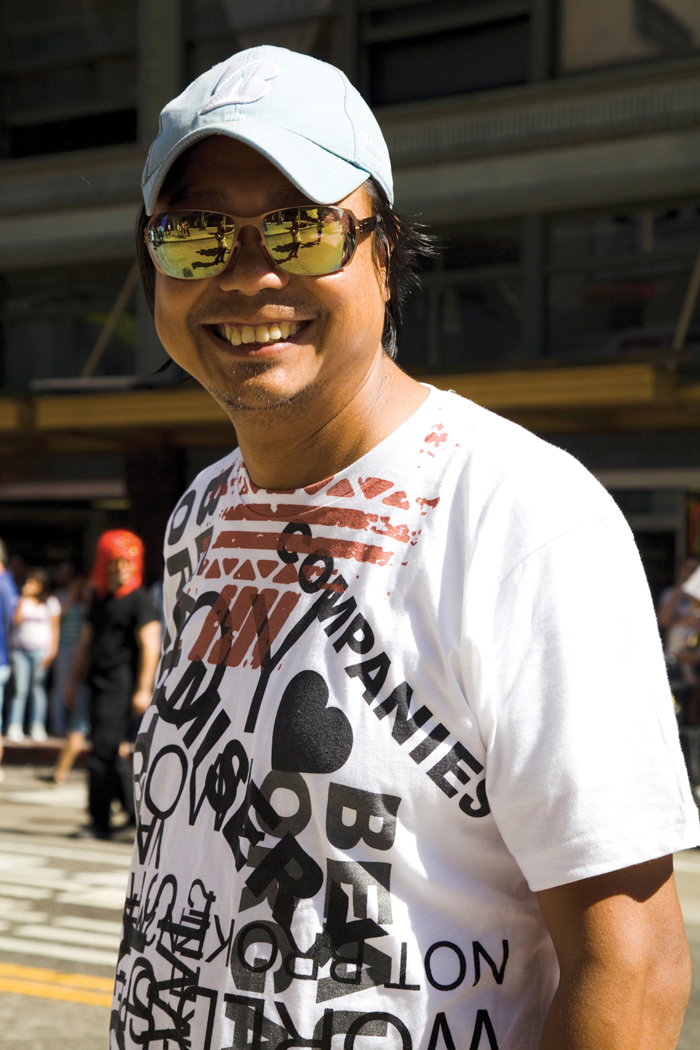
Arto Lindsay, Rirkrit Tiravanija, and West of Rome Public Projects, Trespass Parade, October 2, 2011, Los Angeles. Courtesy of West of Rome Public Art, Pasadena, Ca. Photo: Tina Hosseinzadeh.
Young and Full of Cum
The t-shirts were printed and donated by American Apparel, another of the event’s sponsors. It’s hard to ignore the similarities between the Trespass message and the image of the American Apparel brand. Like an American Apparel ad, Trespass put young and female bodies on display. On top of a float at the head of the parade, a dozen or so girls from South Gate High School moved to Lindsay’s beats in Tiravanija t-shirts and black dance shorts. Near Lindsay’s band, a group of women twirled in sundresses, and a squad of punks stalked the street sporting tight jeans, leather, ripped shirts, cleavage, and cigarettes. As the parade halted in front of the Orpheum Theater, Vaginal Davis led parade-goers in a chant of “Art, Sex, Action, Revolution.” At another stop, Ann Magnuson acknowledged “the young people who are carrying on the tradition of carrying on.” Russian oligarchs are buying all our art, Magnuson continued, but it’s alright because we’re their friends now—and “at least we have a fun art parade!” Perhaps staying above the fray doesn’t require actual transgression or trespassing, but a certain wry narcissism—a parade-cum-protest- cum-fashion show.
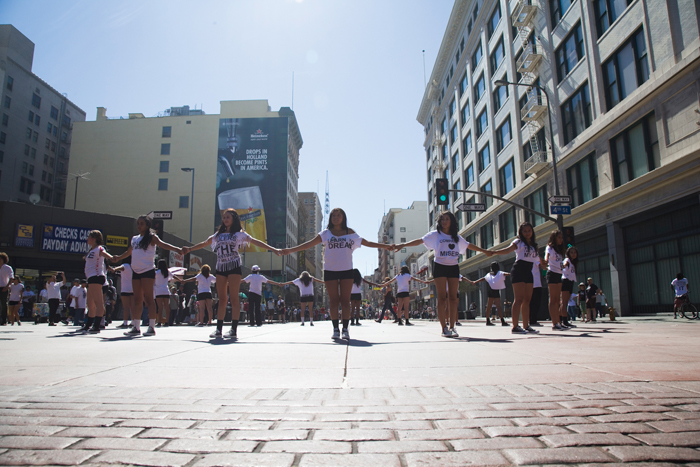
Arto Lindsay, Rirkrit Tiravanija, and West of Rome Public Projects, Trespass Parade, October 2, 2011, Los Angeles. Courtesy of West of Rome Public Art, Pasadena, Ca. Photo: Tina Hosseinzadeh.
Anti-Globalized Aesthetics
Like many contemporary artists, the Trespass organizers are themselves globalized producers and products. West of Rome founder Emi Fontana moved to Los angeles from Italy; Lindsay lives in Brazil, and his music post-DNA is infused with Tropicália; Bangkok-based Tiravanija, who was born in Argentina, has exhibited his full passports as books and prints.7 The parade was followed by a party the next night in Union Station. States the press release, participating artists “integrate[d] underground and cutting edge moments of street life and cultural history in Los Angeles into the party and deliver[ed] it to a sophisticated international art audience of tastemakers.”8 In this statement lingers an indeterminate candidness or cynicism on the part of Tiravanija and company. It seems the emptying-out and repackaging of political forms is their solution to the inadequacies of these same forms. The parade extricated itself from the bothersome specificities of goals or demands, detaching and presenting only a radical aesthetic, a gentrified politics that claimed an identity through its formal proximity to “authentic” demonstrations. One group of marchers held signs referring to social networking websites like Facebook, including one which inadvertently interrogated Trespass: “Is identity about finding oneself or creating oneself?” Tiravanija’s passport is an emblem of nomadic contemporary subjectivity. Here the artist parachutes in to stage a demonstration, elsewhere stops by to spice Swedish meatballs with Thai chilies.9 Ultimately, these relationships have the same quality of ease as Facebook friendships. Liberated from context, the event turned inward.
Affect and the City
Did Trespass enter into the aesthetics of a collectively hallucinated city? If it did, was this enough? Like Tiravanija’s protest wallpaper, Trespass Parade functioned as a kind of protest-themed decoration of shared urban space. West of Rome Public Projects has made similar interventions in the past. For an ongoing project series called Women in the City, the group commissioned artists such as Jenny Holzer and Cindy Sherman to produce outdoor artworks in the form of billboards or wheat-pasted posters. The idea was to insert women artists into an urban environment designed by men. And so, as Renzo Piano designed the Broad wing at the Los Angeles County Museum of Art and Barbara Kruger embellished the elevator, Trespass Parade trespassed nowhere, but decorated wherever it was allowed.
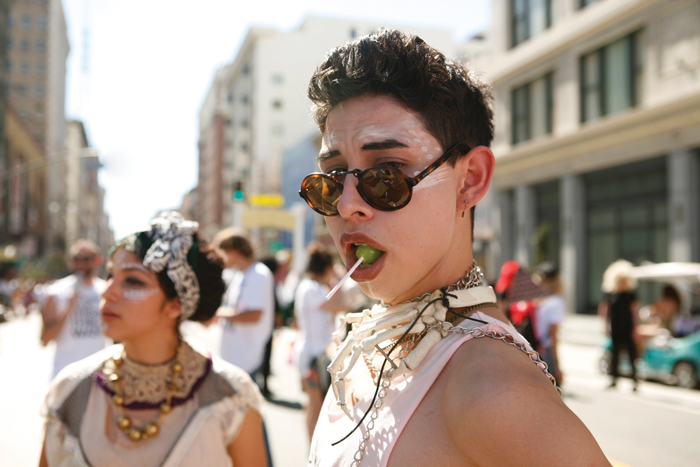
Arto Lindsay, Rirkrit Tiravanija, and West of Rome Public Projects, Trespass Parade, October 2, 2011, Los Angeles. Courtesy of West of Rome Public Art, Pasadena, Ca. Photo: Charchi Stinson.
At the back of the parade, a couple of projects tested the limits of Trespass itself. Dawn Kasper blasted skronking noise from the back of a pickup truck loaded with gear and crumpled paper, overwhelming everything in earshot. Members of the Newspaper Reading Club, organized by Fiona Connor and Michala Paludan, walked down the road with newspapers in front of their faces, presenting sheets of intimate and illegible type, in contrast to the usual loud and pithy protest sign.10 Of course, these and all other entries blended into the general fray, as did the anti-slogans on some of the shirts—Beshty’s “DOLOREM IPSUM,” for example. Like free market capitalism, the parade had the capacity to subsume all opposition.
Occupy L.A.
Something surrounded this mobile zone of art, sex, action, and revolution. It was the city of Los Angeles: Skid Row to the east, with one of the highest concentrations of police in the world; a “revitalized downtown” to the west, boasting high-rise artist lofts starting in the low $300Ks; to the south, the fashion district and the American Apparel factory; and to the north, the Los Angeles civic center. The parade moved northward on Broadway to 1st Street then turned west towards the Walt Disney Concert Hall. As the parade rounded the corner, Chris Kraus interviewed long-time collaborator Sylvére Lotringer on the top of a float. “We’re working in a system that wants us dead,” said Lotringer. “This is only a first step—a symbolic step.” Meanwhile, marchers dressed as rabbits rolled a huge chunk of fake log up Bunker Hill—a symbolic final push.
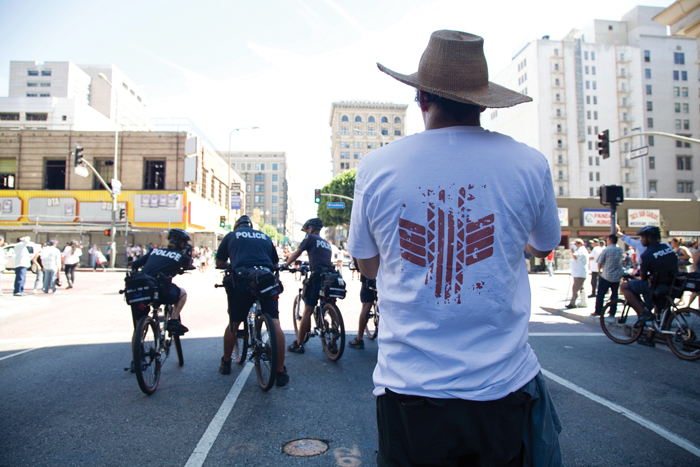
Arto Lindsay, Rirkrit Tiravanija, and West of Rome Public Projects, Trespass Parade, October 2, 2011, Los Angeles. Courtesy of West of Rome Public Art, Pasadena, Ca. Photo: Tina Hosseinzadeh.
Here the parade was joined by demonstrators from Occupy L.A., an extension of the Occupy Wall Street protest in New York, who had just spent their first night on the front lawn of City Hall. They led the marchers in a few chants (“Banks got bailed out, we got sold out,” and “We are the 99%!”) then went back to their camp. The parade dissipated, the floats vanished, and organizers shooed people back out of the street. Punk-jazz orchestra Killsonic performed in the MOCA courtyard. Meanwhile a meeting was in progress on the grass crammed with tents, blankets, and signs. At an earlier rally at Pershing Square, a few occupy L.A. demonstrators had cheered the sheriff for providing security. Dozens of protesters left in anger, maintaining that under no circumstances are the police our friends. Police brutality is real, they said. Just wait. Here too the issue seemed to be collusion with established limits: whether to accept the security and traffic control provided by the LAPD, or whether to reject any connection whatsoever to those sworn to the defense of capitalism. As Lakshmi Luthra points out, “Protest can make conspicuous the difference between the people and the state, and compel the police to reveal what side they are on. If society is not a self-identical whole, ‘Protect and Serve’ becomes a hopelessly vague slogan.”11One sign read, “THE 99% INCLUDES THE COPS”—after all, the fantasies of those in power also shape the group-hallucinated city. The Occupy movement struggled to articulate its position while remaining as inclusive as possible. Meanwhile, Trespass succeeded so well in affirming the self-evident value of taking a position—anypositionwhatever—that radical difference was leveled out and effectively concealed—a maneuver that could only benefit the powerful.

Arto Lindsay, Rirkrit Tiravanija, and West of Rome Public Projects, Trespass Parade, October 2, 2011, Los Angeles. Courtesy of West of Rome Public Art, Pasadena, Ca. Photo: Tina Hosseinzadeh.
Empty L.A.
An empty Los Angeles is a city in potentia. Into the voided Broadway cordoned off by police moved an art parade, a kind of limitlessness within limits, affective, celebratory, and temporary. Difference dissolved within the group-hallucinated city; Los Angeles peeled away for a moment and appeared to those present as an empty slab, an architecture of possibility. Such a city, like Gilles Deleuze’s “any-space-whatever,” is malleable in all its aspects, a wasteland of potential “both ruined and fresh.”12 Is art up to the task of reconstruction? Can art gather up solid, living contradictions in its metaphors? Can it do so in a way more productive than self-congratulatory? As it collected various actions, without prejudice, into an illusory consensus, Trespass maintained its emptiness —denying rather than manipulating the real. At a time when the political demonstration is already hyper-aestheticized, with the right inflection, one could wield a blank city as a weapon against signification itself. Indeed, maybe this is what remains for art to accomplish. Yet Trespass cheerfully decorated its costume with inert transgressions. It was in the end a pale staging of an already fantastic group hallucination. As I write this, far weirder things take their course: someone dancing down Wall Street on the edge of Skid Row to the zombie rhythm of meth withdrawal; a quartet of police sirens phasing in and out like a pack of feeding coyotes. To this tweaker, to these cops, surrounded by dire specificity, Trespass urges: keep dancing, keep singing, keep dancing keep singing—and to every citizen: keep marching.
X—
Travis Diehl is an artist and writer living in Los Angeles. His work has appeared in such venues as the Hysterically Real Theater, Curtat Tunnel, Artforum.com, and the Centre Pompidou. He edits the Los Angeles-based magazine Prism of Reality.
